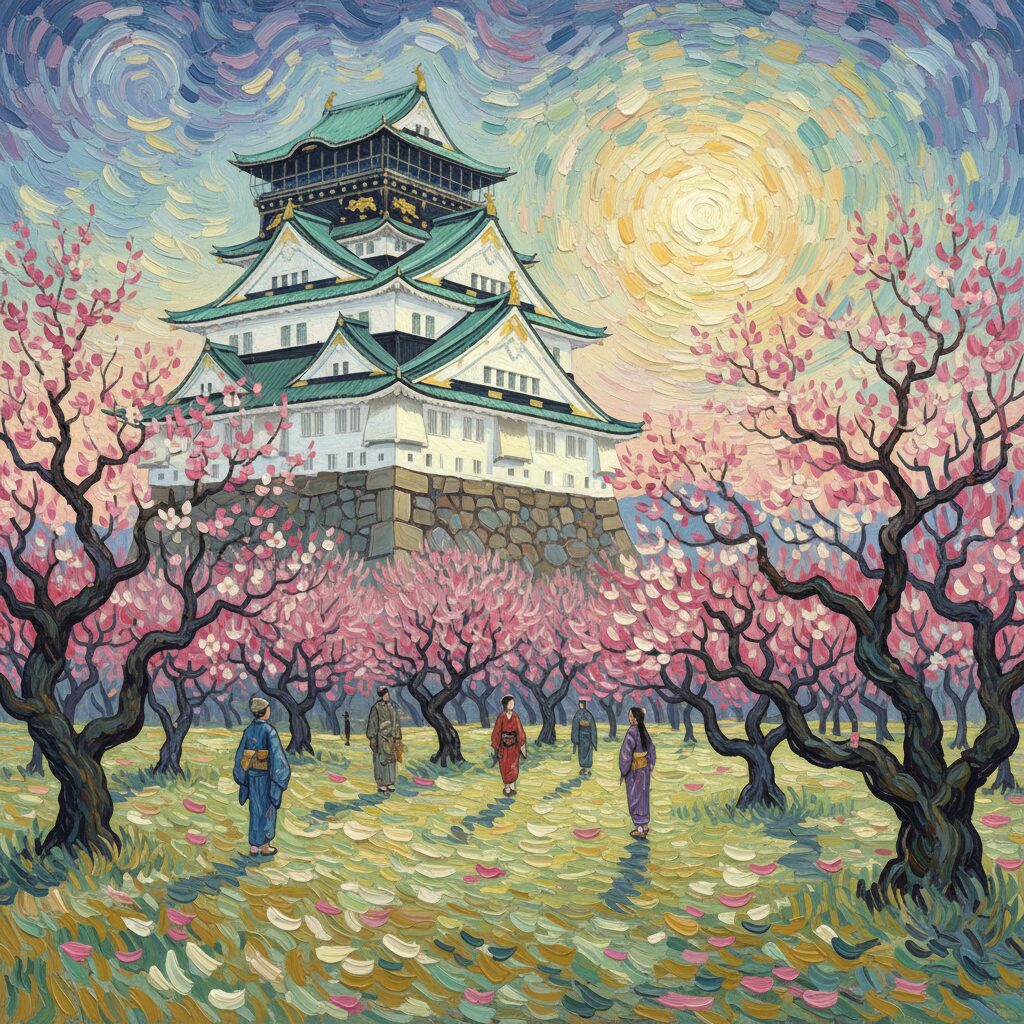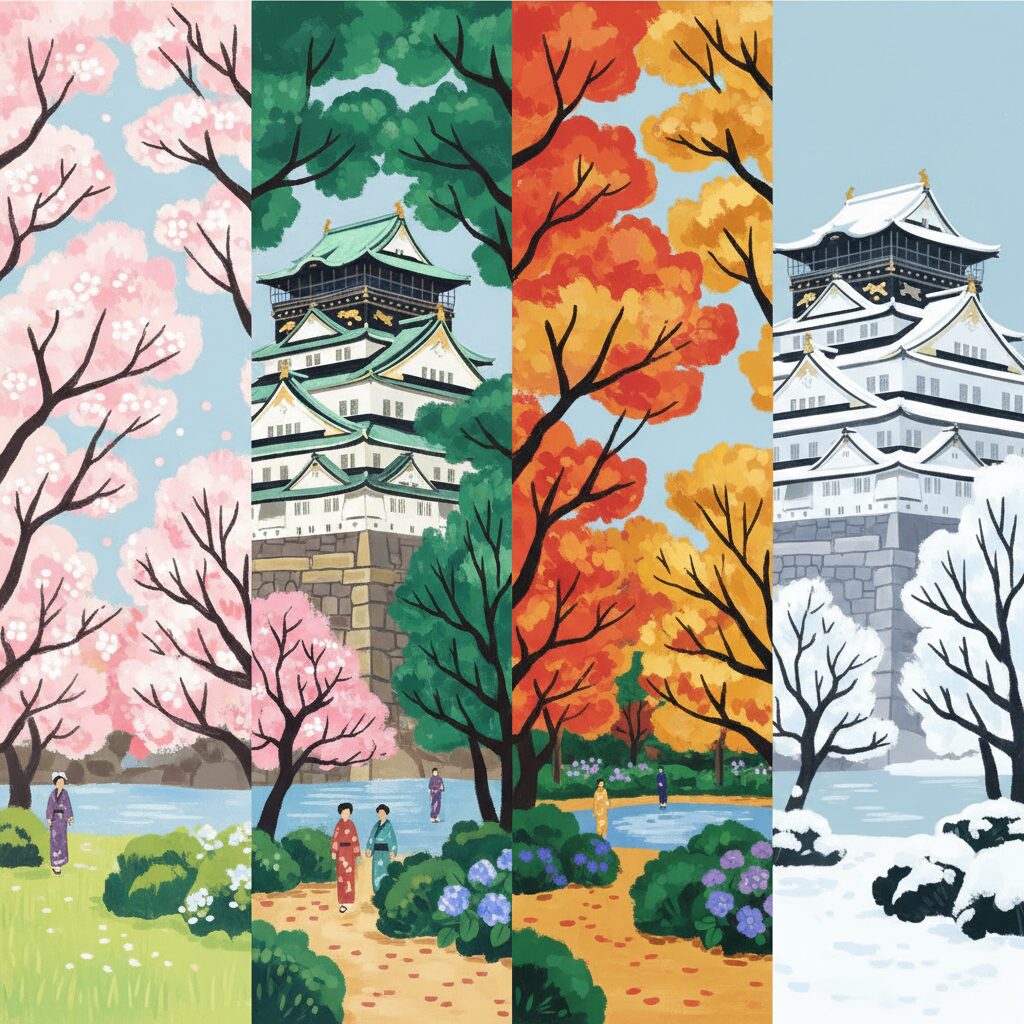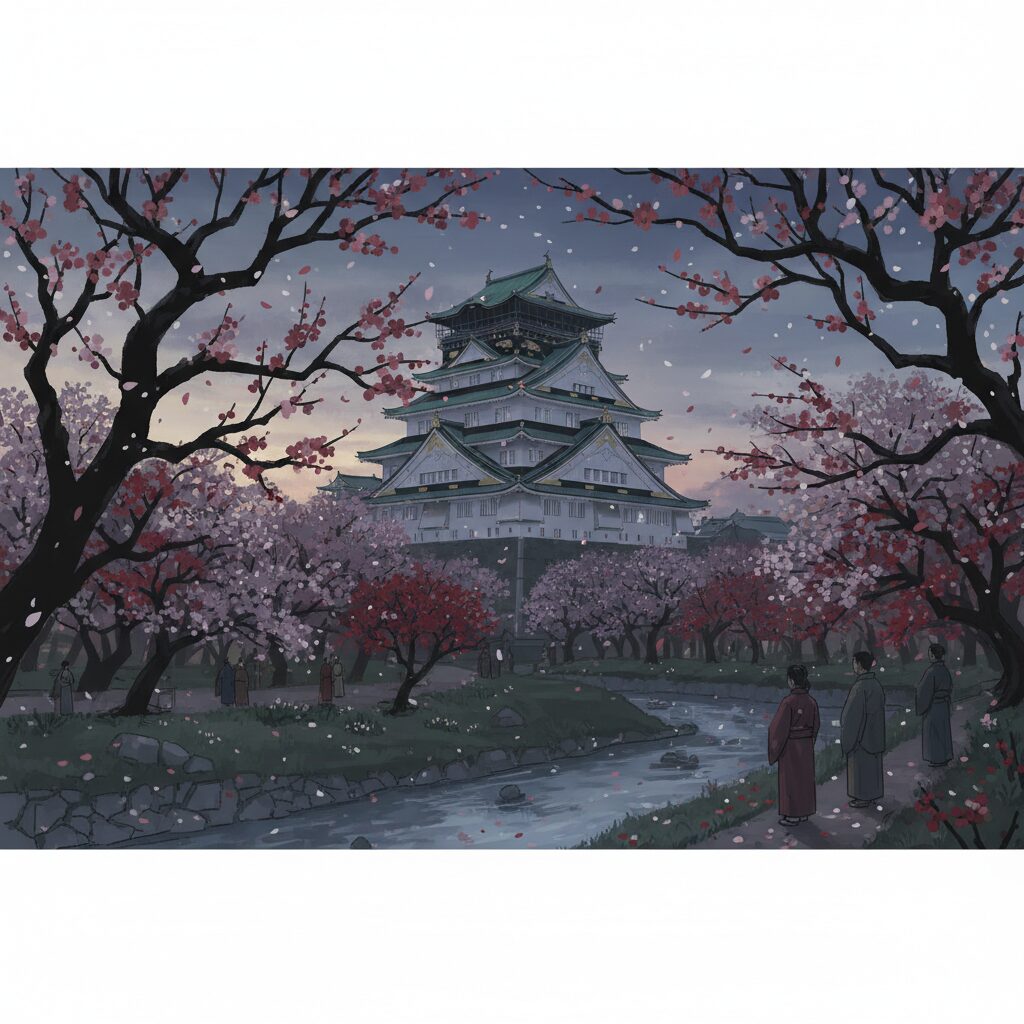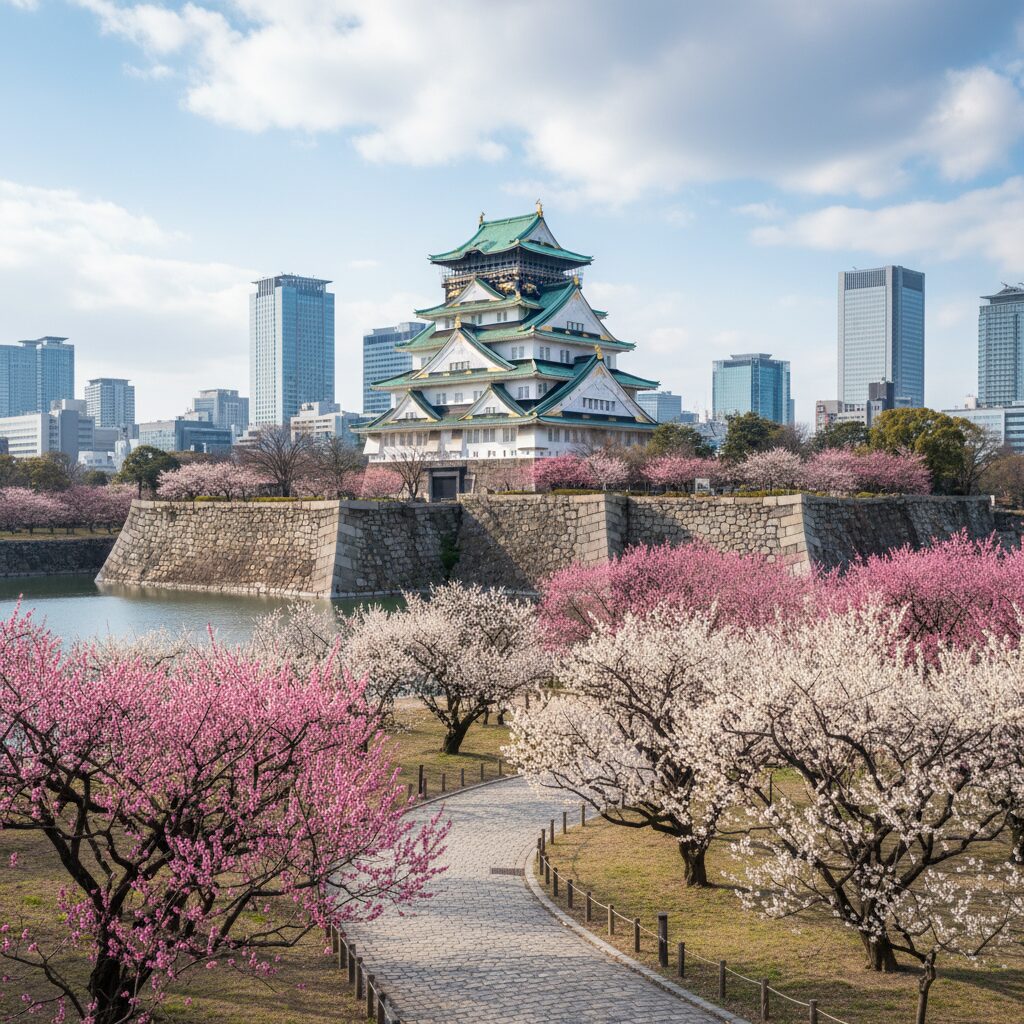Osaka. The name itself crackles with energy, a city of dazzling neon, tantalizing street food, and a rhythm that pulses through its very streets. At its heart stands a silent, stoic guardian: Osaka Castle. A formidable fortress of immense stone walls and soaring eaves, it’s a powerful symbol of ambition, conflict, and unification. For most visitors, the main tower, the Tenshukaku, is the ultimate prize, a magnificent reconstruction that tells a dramatic story of Japan’s history. But to truly understand the soul of this place, you must wander beyond the imposing gates and towering ramparts. You must seek out the softer side of the castle, the spaces where nature has been invited to write its own history in a language of petals and leaves. This is the story of Osaka Castle Park’s two most enchanting realms: the Ume Grove, where the first breath of spring defies the winter chill, and the Nishinomaru Garden, a sweeping lawn that erupts into a celestial sea of cherry blossoms. Here, within the protective embrace of ancient walls, the seasons don’t just change; they perform. They offer a spectacle of color, fragrance, and fleeting beauty that connects you to the very heart of Japanese aesthetics. It is a world away from the city’s hustle, a place to walk, to breathe, and to witness time unfold at the pace of a blooming flower.
To further explore the dramatic history embodied by the Tenshukaku, consider a deeper dive into the samurai legacy of this iconic fortress.
The First Promise of Spring: The Osaka Castle Plum Grove

Long before the first cherry blossom dares to bloom, another flower signals the end of winter. This is the noble plum, or `ume`, a bloom deeply treasured in East Asian culture for its resilience, grace, and captivating fragrance. While cherry blossoms are the undeniable icons of Japanese spring, plum blossoms offer a more intimate, reflective experience. They serve as the prelude to the grand symphony of spring, blooming with quiet confidence against a backdrop of bare branches and crisp air. Nestled in the eastern part of Osaka Castle Park, near the Morinomiya entrance, is one of the largest and most impressive plum groves in western Japan. Spanning a vast area, the grove houses over 1,200 plum trees with more than 100 distinct varieties. It’s not a uniform sea of pink but a complex and nuanced tapestry of colors, ranging from deep magenta and vibrant crimson to the softest blush pink and purest snow white.
An Atmosphere of Quiet Resilience
Strolling through the Ume Grove in late February or early March offers a sensory awakening. The air, still tinged with winter’s chill, carries a sweet, almost spicy perfume distinctly different from the delicate scent of cherry blossoms. This fragrance feels both invigorating and soothing. The atmosphere here contrasts with the lively festivities of cherry blossom season; it is more serene, drawing couples, elderly friends, and artists with their sketchpads and easels. You’ll spot dedicated photographers with long lenses, patiently waiting for a Japanese white-eye bird to land on a branch, its bright green feathers creating a striking contrast against the pink and white petals. The soundscape comprises chirping birds and the gentle rustling of leaves—the perfect peaceful accompaniment to a slow, wandering walk. The trees themselves are artworks in nature. Unlike the soft, rounded shapes of cherry trees, plum trees are often gnarled and angular, their dark, rugged bark telling tales of endurance. Their branches twist and stretch like brushstrokes in a calligraphy painting, forming dramatic silhouettes against the sky. This contrast between weathered wood and delicate, vibrant blossoms is central to the plum’s aesthetic charm, symbolizing strength through adversity and beauty born from hardship—a theme deeply embedded in Japanese philosophy.
A Living Museum of Plum Varieties
The grove’s incredible variety is truly astonishing. As you wander the meandering paths, you’ll notice small wooden placards identifying various types of `ume`. Some trees bear single-layered petals, simple and elegant, while others have dense, multi-layered blossoms resembling miniature roses. Varieties like the `Kankobai` bloom exceptionally early, their deep red flowers boldly standing out against the cold. Other types, such as the `Omoimama`, are renowned for their enchanting ability to produce both red and white blossoms on the same branch—a natural wonder that never fails to amaze. This remarkable diversity ensures a prolonged blooming season, typically from late January to early March. An early visit might treat you to the sight of a few determined trees blooming amid a dusting of snow, a poignant image cherished in Japanese art. Visiting in mid-to-late February usually means the grove is approaching its peak, offering a breathtaking vista of colors with the imposing castle keep visible in the distance, creating a perfect composition of man-made strength and natural grace.
Finding Your Perfect Moment in the Grove
If possible, I recommend visiting the Plum Grove on a weekday morning. The light is gentle, the air fresh, and the crowds sparse, allowing for a full immersion in the tranquil surroundings. Begin your exploration from the Morinomiya Station side of the park, as it provides the most direct access. Wear comfortable, warm footwear, since the paths are unpaved and the ground can be cool. There is no entrance fee to the grove itself, making it an accessible pleasure for all. Don’t just pass through; find a bench, sit awhile, and simply observe. Notice how the light filters through the petals. Close your eyes and breathe in the scent. This is not a place to rush. It is a space for quiet reflection, a floral meditation preparing your spirit for the vibrant burst of spring soon to come.
The Grand Spectacle: Nishinomaru Garden in Full Bloom
If the Plum Grove serves as the quiet prelude, then Nishinomaru Garden is the stunning crescendo. As March transitions into April, a wave of pink and white blossoms sweeps across Osaka, and there is no better place to witness this spectacle than within the western citadel of the castle grounds. The Nishinomaru Garden, a vast 6.5-hectare lawn-covered space, once hosted the residence of Kita-no-Mandokoro, the wife of the renowned warlord Toyotomi Hideyoshi. Today, it has been transformed into a horticultural gem, home to around 300 cherry trees, mainly of the iconic Somei Yoshino variety. Unlike the dense, forest-like feel of other cherry blossom spots, Nishinomaru provides wide-open views. The carefully maintained lawn offers a perfect foreground for the sea of blossoms, with the majestic castle keep rising dramatically behind them. This is the quintessential, postcard-perfect view of Osaka Castle in spring, a scene of unmatched beauty and historical grandeur.
The Energy of Hanami
During peak cherry blossom season, the atmosphere is electric. The tranquility of the Plum Grove gives way to a vibrant sense of joy and communal celebration. This is the season of `hanami`, the cherished Japanese tradition of flower viewing. Families, friends, and colleagues gather on blue tarps spread across the lawn, sharing elaborate bento boxes, sipping sake, and delighting in the moment’s beauty. The air hums with laughter, conversation, and the lively sounds of celebration. It’s a richly immersive cultural experience. As a visitor, you can sense the collective reverence for this fleeting moment of natural perfection. The sight of thousands of people, from toddlers to grandparents, all united in their admiration of the blossoms is deeply heartwarming. While it can be busy, the garden is so expansive that it rarely feels crowded. There is plenty of room to find your own patch of grass, lay down a blanket, and join in the citywide festival.
Nishinomaru by Night: A World of Illumination
Although stunning by day, the garden transforms magically after sunset. During the peak blooming period, an evening illumination event called `yozakura` (night sakura) lights up the garden. The trees are illuminated from below, their blossoms glowing with an ethereal, almost otherworldly radiance against the dark sky. The castle keep is also beautifully lit, creating a dramatic and romantic scene. The lively daytime energy softens into a quieter, enchanting atmosphere. The cool night air, the gentle glow of lanterns, and the ghostly beauty of the illuminated blossoms create an unforgettable experience. It feels like stepping into a dream. For photographers, this is a prime opportunity. The contrast between the glowing pink and white flowers and the dark sky, with the castle as a visual anchor, offers truly spectacular shots. Using a small tripod can help capture the scene sharply in low light.
Practicalities for a Perfect Hanami Experience
Visiting Nishinomaru Garden requires a bit more preparation than the Plum Grove. There is an admission fee (typically a few hundred yen, with longer hours and higher fees during the evening illumination). The entrance is near the Otemon Gate, so the easiest access is often from the Tanimachi Yonchome subway station. To secure a good spot for `hanami`, especially on weekends, arriving early is recommended. It’s common for groups to send one person early to reserve a space with a tarp. As a traveler, you can enjoy the same experience by purchasing a pre-made bento box and a drink from a nearby convenience store or department store basement (`depachika`). Remember to bring a bag for your trash, as it’s customary to leave your area impeccably clean. From a solo female traveler’s perspective, the `hanami` crowds are generally very safe and family-friendly, though as with any large event, it’s wise to remain mindful of your belongings.
Beyond the Blossoms: The Gardens Through the Seasons

While spring is undeniably the highlight season for both Plum Grove and Nishinomaru Garden, their charm extends far beyond just a few brief weeks. To fully appreciate the park is to recognize its appeal throughout the year. Visiting during other seasons reveals different aspects of its character, providing a calmer and more intimate connection to this historic landscape.
Summer’s Lush Embrace
After the last cherry blossom petal falls, the park is wrapped in a rich, vibrant green. The cherry trees of Nishinomaru Garden, now fully leafed, offer abundant shade from the warm summer sun. The expansive lawn invites quiet afternoon strolls or peaceful breaks from sightseeing. The intense greenery of the foliage contrasts beautifully with the bright white castle walls and the deep blue summer sky, creating a perfect scene for photographers. In early summer, the garden also features stunning azalea bushes, bursting with vivid shades of pink, purple, and red, adding another chapter to the park’s floral narrative. The moats encircling the castle grounds come alive with activity, while the air resonates with the hum of cicadas, the quintessential sound of a Japanese summer. It’s a season of tranquil beauty, a time to enjoy the park’s vibrant life and energy at its peak.
Autumn’s Fiery Canvas
As the humid summer air cools, Osaka Castle Park readies itself for a final, colorful display before winter. Though not as renowned as Kyoto’s temples for autumn leaves, the park presents its own stunning spectacle. A magnificent ginkgo tree east of the main tower turns a brilliant, glowing gold, its fan-shaped leaves blanketing the ground beneath. The cherry trees in Nishinomaru Garden shed their green summer attire for warm shades of orange, red, and yellow. The fiery autumn hues strikingly contrast against the steadfast grey stone of the castle walls. The crisp autumn air and clear skies provide ideal walking weather. Fewer visitors than in spring allow for a more relaxed and reflective tour of the grounds. This season offers a perfect opportunity to explore the castle’s history by visiting the main keep and surrounding turrets, enhanced by the beauty of the autumn foliage.
A Guide to Navigating and Maximizing Your Visit
Osaka Castle Park is vast, spanning more than one hundred hectares. Familiarizing yourself with its layout and access points is essential for a smooth and enjoyable visit. The park is bordered by several train and subway stations, each providing a distinct route and experience.
Selecting Your Entrance
- Morinomiya Station (JR Loop Line, Chuo and Nagahori Tsurumi-ryokuchi subway lines): Often considered the best entrance for those visiting the Plum Grove, this station is located at the park’s southeastern corner, just a short walk away. It’s near a fountain and a large open space, making it a pleasant and straightforward entry point.
- Osakajokoen Station (JR Loop Line): Positioned on the northeast side, this station offers easy access to Osaka-jo Hall and Jo-Terrace Osaka, a modern complex with eateries and shops. From here, you approach the castle via the Aoyamon Gate, providing a slightly different viewpoint.
- Tanimachi Yonchome Station (Tanimachi and Chuo subway lines): This entrance offers the traditional, historical route. Exiting here brings you to the park’s southwest corner, leading directly to the impressive Otemon Gate, the main entrance to the inner citadel. This route is perfect for first-time visitors seeking the full dramatic experience and is the most direct way to Nishinomaru Garden.
Helpful Tips for a Seamless Visit
- Wear Comfortable Shoes: This advice cannot be emphasized enough. You will be walking extensively on paved paths, gravel, and grass. The park is extensive, and distances between points of interest may be longer than expected.
- Check Bloom Forecasts: If your visit focuses on plum or cherry blossoms, make sure to consult the bloom forecasts (`kaika yosou`) online. They are updated frequently and highly reliable. Peak cherry blossom season, in particular, can last only about a week, so timing is critical.
- Stay Hydrated and Be Prepared: While vending machines and a few cafes are scattered around the park, bringing your own water is a smart choice. Sunscreen and a hat are essential during summer, and dressing in layers is advisable in cooler months due to temperature changes.
- Explore Beyond the Gardens: Although the gardens are highlights, don’t overlook other attractions. Visiting the main castle tower is a must for historical insight and panoramic views from the top floor. The Hokoku Shrine, dedicated to Toyotomi Hideyoshi, offers a tranquil and beautiful retreat. The Miraiza complex, once a military headquarters, now houses shops and restaurants, blending history with modern life right at the castle’s base.
- Take Your Time: The best way to enjoy Osaka Castle Park is at a leisurely pace. Avoid rushing between photo spots. Allow yourself to wander off the main trails, sit on a bench by the moat, and simply soak in the atmosphere. It is often in these peaceful moments, away from the crowds, that the park’s true charm emerges.
A Final Reflection on Petals and Power

Visiting the gardens of Osaka Castle is to encounter a beautiful paradox. Here, in the shadow of a fortress built for war and defense—a symbol of great power and political struggle—there exists a world of delicate, fleeting beauty. The twisted branches of the plum trees and the transient cherry blossoms tell another story—one of resilience, renewal, and the gentle, unstoppable passage of the seasons. They remind us that even in places marked by strength and stone, there is space for softness, for poetry, and for the simple yet profound joy of witnessing a flower bloom. Whether you stroll beneath fragrant plum blossoms on a crisp winter morning or celebrate with thousands beneath a canopy of cherry blossoms, you partake in a tradition that connects you to centuries of Japanese culture. You are seeing more than a castle; you are seeing its soul.



